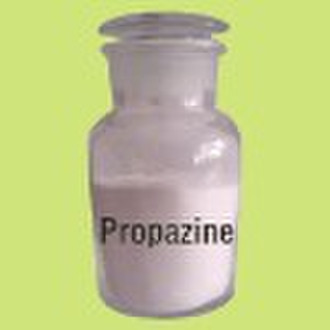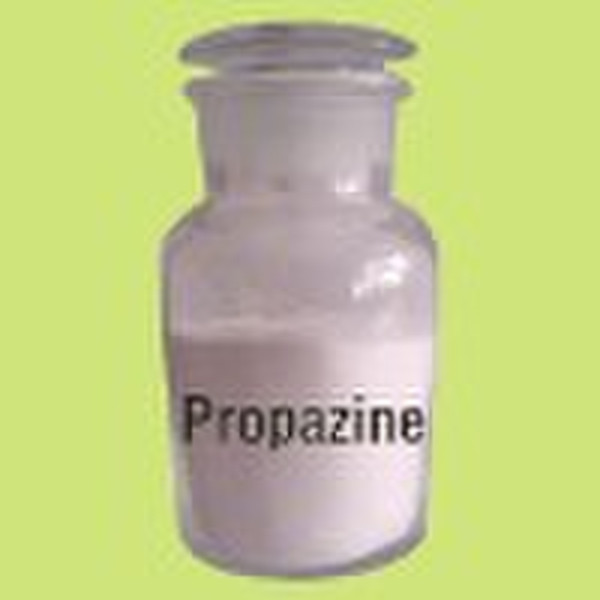Propazine96%的技术合作,97%的技术合作的50%SC

Jianfei Yuan
联系人姓名
基本信息
| 分类 | Fungicide |
|---|---|
| 化学文摘社编号. | 139-40-2 |
| 出生地 | Jiangsu China (Mainland) |
Common Name PropazineAppearance: Propazine is a colorless crystalline solid under normal circumstances . Chemical Name: 6-chloro-N2,N4-di-isporopyl-1,3,5-triazine-2,4-diyldiamine CAS Number: 139-40-2 Molecular Weight: 229.70 Water Solubility: 5 mg/L Solubility in Other Solvents: difficult to dissolve in organic solvents: in benzene, toluene, carbon tetrachloride, and diethyl ether Melting Point: 212-214 C Vapor Pressure: 0.004 mPaPartition Coefficient: Not Available Adsorption Coefficient: 154 Trade and Other Names: Trade names include G-30028, Geigy 30028, Gesamil, Milocep, Milogard, Milo-Pro, Plantulin, Primatol P, Propazin, Propinex, and Prozinex. Regulatory Status: Propazine is classified as a slightly toxic compound in EPA toxicity class III and as a General Use Pesticide (GUP). Labels for products containing propazine must bear the Signal Word CAUTION. Toxicological Effects: Acute toxicity: Propazine is slightly toxic by ingestion with reported oral LD50 values of 3840 mg/kg to greater than 7000 mg/kg in rats, 3180 mg/kg in mice, and 1200 mg/kg in guinea pigs . It is slightly toxic dermally; slight irritation was noted after propazine was applied to the skin of rabbits . Its dermal LD50 in rats is 10,200 mg/kg, and in rabbits is greater than 2000 mg/kg . Eye applications of 400 mg caused mild eye irritation in these animals . The inhalation LC50 is greater than 2.04 mg/L , indicating slight toxicity by this route as well. Symptoms of exposure may include dizziness, lethargy, muscular weakness, runny nose, emaciation, diarrhea, labored breathing, and irregular breathing . It may be mildly irritating to the skin, eyes, and upper respiratory tract. Contact dermatitis has been reported among workers manufacturing propazine . Chronic toxicity: When given daily to rabbits for 1 to 4 months, oral doses of 500 mg/kg/day propazine were reported to cause a type of anemia . No gross signs of toxicity or pathologic changes were evident in rats that received daily doses of 250 mg/kg of propazine for 130 consecutive days . No clinical or physical toxic symptoms were observed in beagle dogs fed 1.25, 5, or 25 mg/kg/day of a propazine formulation in 90-day feeding studies . Reproductive effects: There was an increase in the number of deaths of newborns born to female rats that were given 5 mg/kg/day of propazine during 18 days of pregnancy [44]. In a three-generation study with rats fed 0.15, 5, or 50 mg/kg/day, no effects on fertility, length of pregnancy, pup viability or pup survival were observed . The data regarding reproductive effects are inconclusive. Teratogenic effects: Maternal doses of 500 mg/kg/day resulted in maternal toxicity and developmental toxicity expressed as increased incidence of extra ribs, incomplete bone formation, and decreased fetal body weights in rats . At 50 mg/kg/day, pup body weights on day 21 of lactation were reduced, and there were pathological changes in organ weights in the second and third generation . These data suggest that teratogenic effects due to propazine are not likely unless the level of exposure is high. Mutagenic effects: Propazine has shown no mutagenic effects in tests conducted on human and rat liver cells and in live hamsters . Carcinogenic effects: No evidence of increased tumor frequency was detected in a 2-year study in mice fed doses up to 450 mg/kg/day of propazine . When rats were fed 0.15, 5, or 50 mg/kg of propazine each day for 2 years, there was an increase in the incidence of mammary gland tumors at the highest dose level .The data regarding carcinogenicity are inconclusive. Organ toxicity: Liver damage is one of the suspected effects of propazine .The functioning of certain liver processes was decreased in rats which were given 2500 mg/kg/day propazine.Fate in humans and animals: Propazine is readily absorbed and metabolized in the body [33]. At 72 hours after administration of single oral doses of propazine to rats, 66% of the dose was excreted in the urine and 23% was excreted in the feces . This study also indicated that 77% of the dose was absorbed into the bloodstream from the gastrointestinal tract. At 8 days after the dosing, propazine or its metabolites were detected in the rats' lungs, spleen, heart, kidneys, and brain .
交货条款及包装
Packaging Detail: 25kg Drum, 200L Iron Drum, or follow your needs Delivery Detail: According to the quantity
端口: shanghai
付款条款
Documents Against Payment
Letter of credit
Telegraphic transfer
-
支付方式
我们接受:









